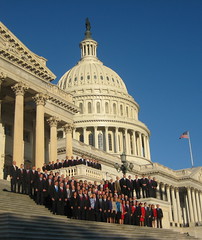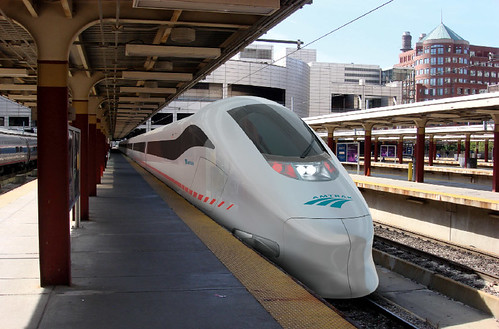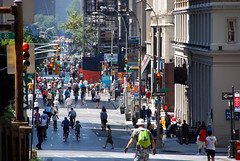|

Image by Talk Radio News Service. |
Congress passed a major transportation bill last week, authorizing more than $100 billion in spending for highways, transit, and other modes over the next 2 years. The bill changes a number of rules and shifts the ways in which money is distributed, in an effort to preserve highway funding.
The bill generally maintains the status quo of federal transportation spending, but attempts to stretch the amount of money available for highways by eliminating or consolidating fringe programs, and shifting money from grants to loans.
$54.6 billion will be available per year, for the next 2 years. About 80% of funding will go to highways, and about 20% will go to transit. Both the overall funding level and the 80/20 split are comparable to existing allocations.
The gas tax will remain at 18.3¢ per gallon, as it has since 1993 when gas was $1.07. Since this won’t produce enough revenue to maintain current spending, almost $20 billion in federal general fund money will be infused in to the transportation fund.
Highways
As in every previous federal transportation authorization, the bulk of spending authority goes to highways. Most of the money will be automatically distributed to state Departments of Transportation, which will have the authority to determine spending on roads within their borders.
Little about this system will change, except that a little bit more money is available for highways due to cuts to other modes.
One thing that may change relating to highways is the make-up of the fleet of cars and trucks using them. This bill eliminates the so-called “gas guzzler tax, ” which raised a small amount of money but was a disincentive towards buying the least efficient cars and SUVs.
Another change is that more funding, up to $1 billion per year, is being directed to the TIFIA program, which offers loans to states and localities for major capital projects, instead of direct grants. TIFIA loan details are more favorable than private market deals, so this is a good option for large projects that don’t get grants. Meanwhile, by expanding a program that requires participants to pay it back, the feds stretch limited dollars further.
Transit
At one stage of negotiations, Republicans in Congress sought to eliminate transit funding altogether. That would have been a disaster. Thankfully it didn’t happen.
Much of the transit money flows to transit providers through automatic formulas, similarly to how highway money flows to state DOTs. The largest pot of non-automatic money is in the New Starts program, which is the major federal source for money to build new rapid transit routes.
New Starts is funded at $1.9 billion per year, which is $50 million per year less than the existing allocation.
For that money, the list of project types that are eligible to receive New Starts grants has been broadened, to include more BRT projects, as well as projects that expand the core capacity of existing transit lines. Also, a special category has been established for “demonstration projects” that are primarily funded with local or private money, and only need a little federal funding.
New Starts is extremely important. Virginia received $900 million from it to help build the Silver Line, and Maryland is counting on it to help fund the Purple Line, Corridor Cities Transitway, and Baltimore Red Line. Expanding the list of eligible uses is good, but it further spreads out an already diminished pot of money.
The competition for New Starts grants will be fierce, and the supply definitely won’t meet the demand.
Another change from previous law is that tax-exempt benefits for transit riders will continue to be capped at $125/month, while car drivers will continue to be eligible for corresponding parking benefits of up to $240/month. This is a blatant subsidy for driving over transit use, and is extremely unfortunate.
Some positive news is that there are two new transit programs established in the bill.
The first is a safety program that will institute nationwide safety standards for railcars, and require large transit agencies to establish safety plans. This is a direct outgrowth of WMATA’s problems in recent years, especially the June 2009 Metrorail crash.
The second new program will offer planning grants to help communities plan and build Transit Oriented Developments around transit stations, which is a nice win for smart growth.
Bike/ped
Bicycle and pedestrian funding was a major target for attack, and a major point of contention. Many rural and conservative congresspeople don’t understand the importance of these modes to urban transportation, and view them as unnecessary luxuries.
At several points throughout the negotiation process, it looked like dedicated bike/ped funding might be eliminated entirely. With the final adopted bill, it was reduced from about $1 billion annually to about $700 million annually. That’s too bad, but the fact that any survived at all is good news.
Of that $700 million, half will be distributed via automatic formula to Metropolitan Planning Organizations (MPOs) for use on bike/ped projects. Previously all of this money had been distributed to states, so sending it to metropolitan areas is an interesting change, and could be seen as an experiment in funneling money directly to metropolitan areas instead of through states.
Unfortunately, the other half of the $700 million in bike/ped money will go to state DOTs, who will have the option of either using it for bike/ped projects, or of flipping it in to their highway funds and using it for road projects. If all the states do this, it will decrease the total amount of federal bike/ped funding to just $350 million.
Although it is not strictly a dedicated bike/ped fund, another pot of money that is often used for bike/ped projects is the Congestion Mitigation and Air Quality program (CMAQ). Capital Bikeshare has largely been funded via CMAQ, so it is a significant program.
The good news is that CMAQ funding levels appear to be level. The bad news is that the list of eligible project types that can use CMAQ funds has been broadened to include a larger variety of road projects.
Environmental issues
Republicans in Congress had wanted to include in the bill funding for the Keystone Pipeline, which would have transported crude oil from Canada to refineries in the US. Democrats opposed it, and the fight was one of the most widely-reported sticking points in the negotiations.
Funding for the pipeline was not included, which was the major Republican concession agreed upon, in response to Democrat concessions regarding bike/ped and transit funding.
However, another aspect of the bill may have even more important and widespread effects.
A rarely-reported provision aimed at streamlining project delivery will eliminate the requirement for federal environmental review for a wide range of projects, including those within existing right-of-way, those that are below certain cost thresholds, and those that replace damaged infrastructure.
Excluding those projects will undoubtedly save millions of dollars, and months or even years of project planning. But it will also eliminate a key step in project review, and reduce the ability of localities to object to undesirable projects imposed on them by states. It is definitely a mixed blessing situation.
Summary
Just about everyone in the transportation policy world agrees that the current federal funding system isn’t working. Costs keep rising, and with the gas tax flat, spending power keeps dropping. Unfortunately, not everyone agrees about what to do.
Some want to find more sustainable revenue sources, and use them to build multimodal 21st Century infrastructure. Others want to eliminate multimodal programs and focus on spending limited money on what they see as the most important priority, highways.
This bill is a compromise. It puts off the larger questions of our country’s long term needs, and takes a slight regressive lean, in order to continue for 2 more years the overall status quo of an 18.3¢ tax going to an 80/20 highway/transit split.
 Cross-posted at Greater Greater Washington.
Cross-posted at Greater Greater Washington.
Average Rating: 4.6 out of 5 based on 236 user reviews.

















